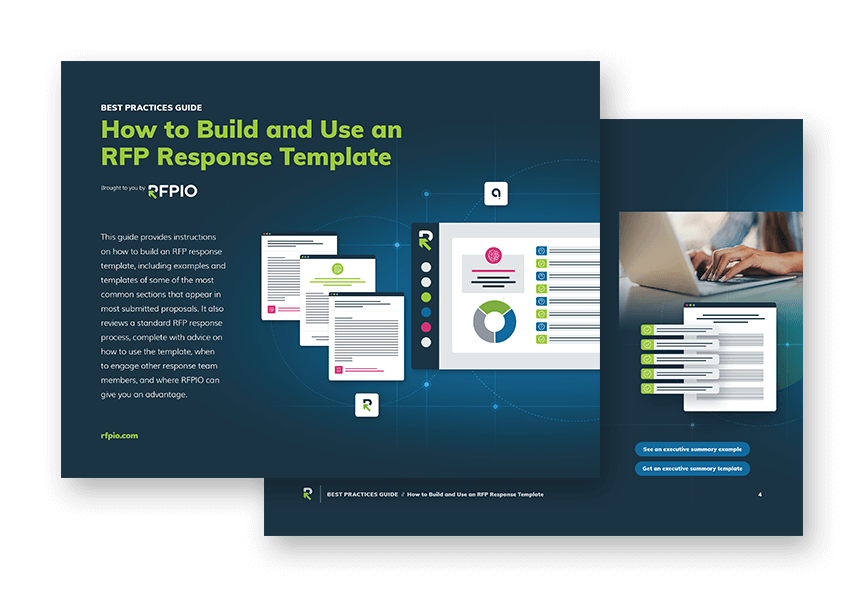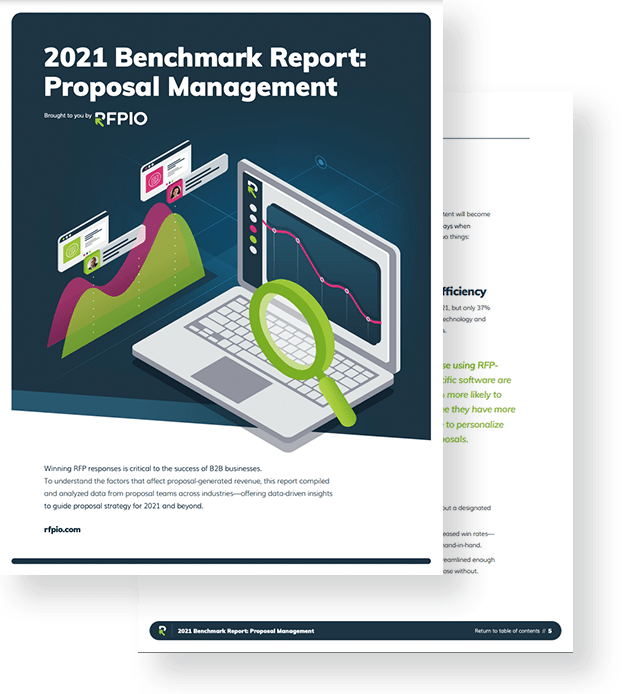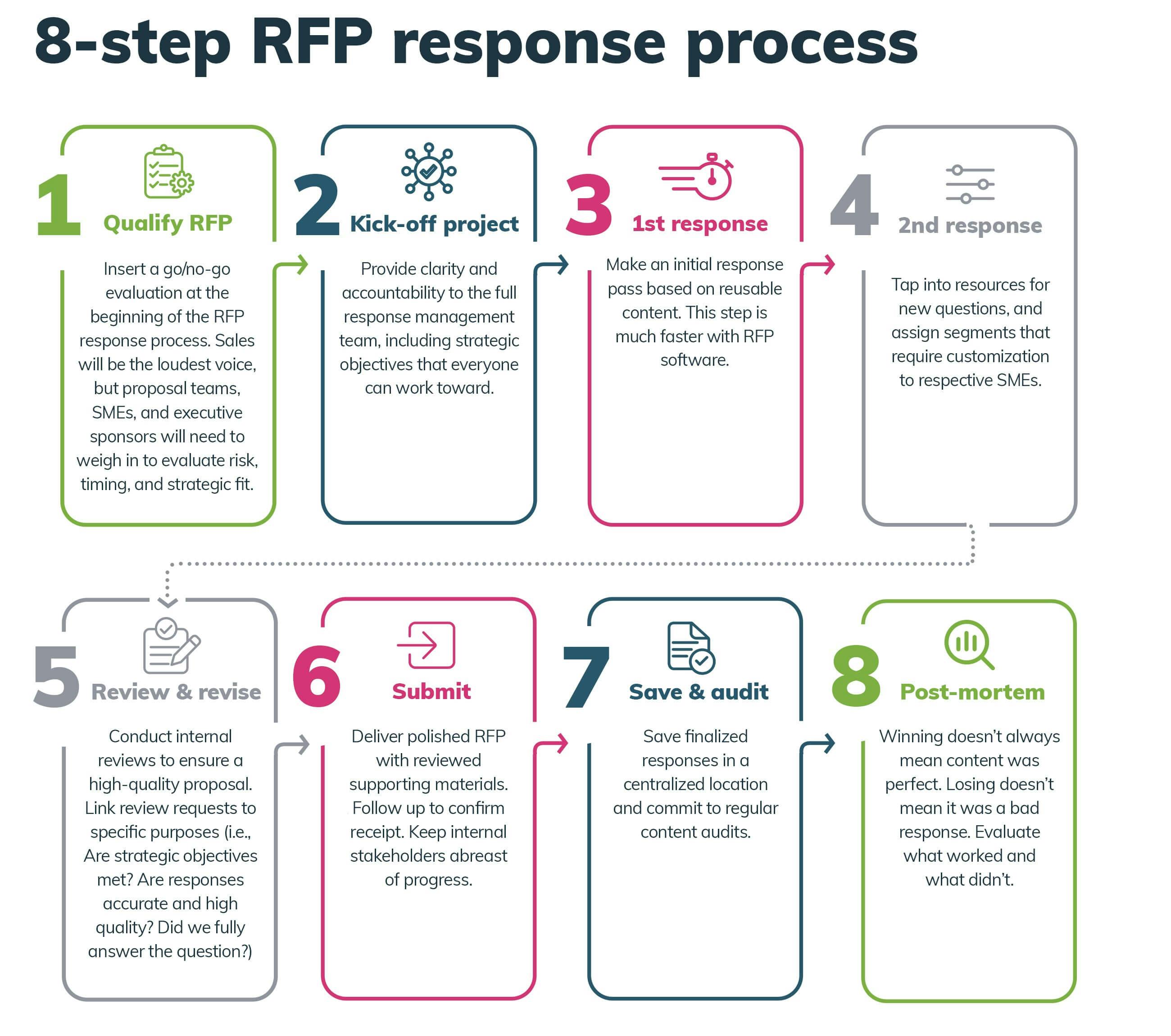Let’s start with the good news: You have an RFP response process. You’d be surprised to know how many companies don’t even have that. If you don’t have a process yet, then I recommend reading How to create an RFP response process as well.
Now the bad news: It needs work. I can help. Let’s look at how to improve your RFP response process.

Guide: How to Build and Use an RFP Response Template
Discover how to build better RFP response templates and get tips and insights on improving your RFP response process.
First, take inventory: How are RFPs viewed within your organization?
Before you improve, take a look at what you have and why. Does your organization view RFPs as a strategic revenue stream or a box to be checked? If the latter, are executive sponsors in place to help you lead the process change?
Change management is real. If past attempts to prioritize RFPs in the sales process were mishandled, then you may still be feeling the pain. If this will be your first sales process change as it pertains to RFPs, then how it’s managed will be just as important as what is implemented.
One advantage of improving your RFP response process now is that salespeople and customers are more open to change than they may have been prior to the pandemic. As people quickly adapted to a “new normal,” Microsoft’s CEO, Satya Nadella, said, “We saw two years of digital transformation in two months.”
However, if you’re like most organizations, the change will need to take place while maintaining current staff levels. According to our 2-person team successfully responded to 16 RFPs that were stacked on top of each other a year after having to push back on the same expectation. Hopefully these tips will help you attain the same kind of results.
Step 1: Only chase RFPs you can win
One of the best ways to make your RFP response process more effective is to stop wasting time on unqualified RFPs. Do this by setting up a qualification step or a go/no-go decision. Consider the following during this step:
- What was your level of involvement prior to the RFP being issued? RFPs are not the optimal time for cold calls. Odds are definitely better when you’ve been invited to respond to an RFP because request for information (RFI) or the prospect has done extensive research on you and your competitors.
- Is your solution a fit? At minimum, it needs to meet the mandatory requirements. Everyone’s agile. Everyone’s flexible. Issuers already know that. You need to be able to prove that you have a battle-tested solution. If proof isn’t required in the RFP, then it will be at onboarding or implementation. RFPs fall into the category of “under promise, over deliver”; doing the opposite will sabotage future support, renewal, and upgrade efforts.
- Does your price match the prospect’s budget? Of course there’s give and take when considering the opportunity and what it means to your business now and in the future. Nevertheless, the issuer will expect your solution to come with everything promised in your response. Whatever the cost to deliver on expectations, make sure you’re being fair to your prospect, your product, and your team responsible for supporting those expectations.
- Is it a strategic fit? RFPs take a lot of time and effort, but not nearly as much time and effort as onboarding and supporting a customer that doesn’t fit your business or product development strategy. There are few things more frustrating than submitting and winning an RFP only to find out that you cannot follow through because it’s not a strategic fit for you or the issuer.
- Do you have bandwidth? Too often, this consideration gets pushed to the side. It’s especially important if you’re responding to unqualified bids! It’s completely understandable to want to respond to more RFPs (we found that RFP software such as RFPIO, you can use full-time proposal manager in place, then you’d be hard-pressed to find a better reason to hire one than to improve and own your RFP response process.Initiate a kickoff meeting for every response to discuss strategy and expectations with the entire response team.
Surface scheduling conflicts, content gap concerns, or issues with deadlines to avoid surprises. Find a way to integrations with several channels to make it easier, including email, Slack, Microsoft Teams, Google Hangouts, and Jira. Maybe you have an SME who hates writing. Call him up and have him talk out the answer, then you write it out. Putting in the legwork to build relationships with your resources will pay off at crunch time.
Step 5: Rinse & repeat
Any improvements need to be repeatable. For example, if you bring in a contract proposal manager for a response, then be prepared to do so every time. This is a process you will cycle through for every RFP. If it works as well as it should, then you may want to carry the process over to other responses, such as security questionnaires or due diligence questionnaires (DDQs).

The 2021 Benchmark Report: Proposal Management
Learn about the state of proposal management, and see what teams need to do to be successful in 2021
8-step RFP response process
- Qualify RFP: Insert a go/no-go evaluation at the beginning of the RFP response process. Sales will be the loudest voice, but proposal teams, SMEs, and executive sponsors will need to weigh in to evaluate risk, timing, and strategic fit.
- Kick-off project: Provide clarity and accountability to the full response management team, including strategic objectives that everyone can work toward.
- 1st response: Make an initial response pass based on reusable content. This step is much faster with RFP software.
- 2nd response: Tap into resources for new questions, and assign segments that require customization to respective SMEs.
- Review & revise: Conduct internal reviews to ensure a high-quality proposal. Link review requests to specific purposes (i.e., Are strategic objectives met? Are responses accurate and high quality? Did we fully answer the question?)
- Submit: Deliver polished RFP with reviewed supporting materials. Follow up to confirm receipt. Keep internal stakeholders abreast of progress.
- Save & audit: Save finalized responses in a centralized location and commit to regular content audits.
- Post-mortem: Winning doesn’t always mean content was perfect. Losing doesn’t mean it was a bad response. Evaluate what worked and what didn’t.
Bonus step: Get a good set of tools

Bonus step: Get a good set of tools
RFPs are becoming more complex. As technology has evolved, expectations have risen. With the capacity to answer more questions, issuers want to ask more questions.
In the past, RFPs were issued with the issuer not knowing if a solution even existed, let alone the company that could provide it. Now there’s a lot of research done online. Typically, there are multiple touchpoints with a prospective solution provider before an RFP is even issued.
In 2021, companies that use RFP-specific software responded to 43% more RFPs than those who use other solutions or techniques. They were also 25% more likely to agree that their processes are streamlined enough to make time to tailor their proposals to the issuers’ specific use-cases.
RFP software can contain and drive your response process. In RFPIO’s case, AI-enabled automation and collaboration begin at intake and carry all the way through to your postmortem.
For those increasingly popular but sometimes maddening online response portals, RFPIO® LookUp can help. The theory behind online portals is that they make RFPs easier. For the issuers, maybe. But not for responders. Even though you can have as many proposal team members respond as you want, there’s no visibility. If multiple responders are updating and changing answers then version and quality control are at risk. RFPIO® LookUp lets you work directly from your Content Library to fill out the online portal without having to leave your browser.
I hope this helps you formulate your next steps for improving your RFP response process. Eventually, you’ll be able to respond to more RFPs or improve the quality of your proposals, or both! You’ll also have a transparent, repeatable process that your proposal team and organization as a whole can rely on to push RFPs as a strategic revenue stream.

